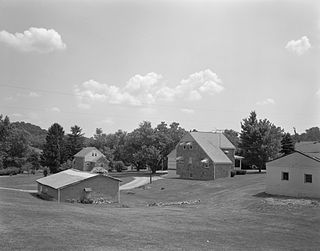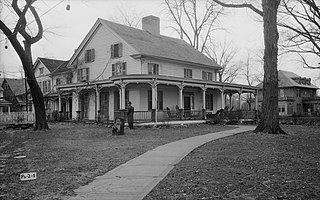
Luzerne County is a county in the Commonwealth of Pennsylvania. According to the United States Census Bureau, the county has a total area of 906 square miles (2,350 km2), of which 890 square miles (2,300 km2) is land and 16 square miles (41 km2) is water. It is Northeastern Pennsylvania's second-largest county by total area. As of the 2020 census, the population was 325,594, making it the most populous county in the northeastern part of the state. The county seat and largest city is Wilkes-Barre. Other populous communities include Hazleton, Kingston, Nanticoke, and Pittston. Luzerne County is included in the Scranton–Wilkes-Barre–Hazleton Metropolitan Statistical Area, which has a total population of 555,426 as of 2017.

Wyoming is a borough in the Greater Pittston area of Luzerne County, Pennsylvania, United States. It is located 5 miles (8 km) north of Wilkes-Barre, along the Susquehanna River. The population was 3,097 as of the 2020 census.

The Wyoming Valley is a historic industrialized region of Northeastern Pennsylvania. The region is historically notable for its influence in helping fuel the American Industrial Revolution with its many anthracite coal-mines. As a metropolitan area, it is known as the Scranton/Wilkes-Barre metropolitan area, after its principal cities, Scranton and Wilkes-Barre. With a population of 567,559 as of the 2020 United States census, it is the fifth-largest metropolitan area in Pennsylvania, after the Delaware Valley, Greater Pittsburgh, the Lehigh Valley, and the Harrisburg–Carlisle metropolitan statistical areas.

West Overton is located approximately 40 miles (64 km) southeast of Pittsburgh, in East Huntingdon Township, Westmoreland County, Pennsylvania, United States. It is on PA 819 between the towns of Mount Pleasant and Scottdale. Its latitude is 40.117N and its longitude is -79.564W.
The Luzerne County Historical Society is one of the oldest continually operating local historical societies in America. It was founded on February 11, 1858, in recognition of the 50th anniversary of the first successful burning of anthracite coal by Jesse Fell, and was originally named the Wyoming Historical and Geological Society. The organization operates the historic Swetland Homestead in Wyoming, Pennsylvania and the Luzerne County Museum which also features a separate research library in Wilkes-Barre, Pennsylvania. It also administers the Nathan Denison house.

The Cogan House Covered Bridge is a Burr arch truss covered bridge over Larrys Creek in Cogan House Township, Lycoming County, in the U.S. state of Pennsylvania. It was built in 1877 and is 94 feet 2 inches (28.7 m) long. The bridge was placed on the National Register of Historic Places in 1980, and had a major restoration in 1998. The Cogan House bridge is named for the township and village of Cogan House, and is also known by at least four other names: Buckhorn, Larrys Creek, Day's, and Plankenhorn.

Fort Gaddis is the oldest known building in Fayette County, Pennsylvania and the second oldest log cabin in Western Pennsylvania. It is located 300 yards (270 m) east of old U.S. Route 119, near the Route 857 intersection in South Union Township, Fayette County, Pennsylvania. Fort Gaddis was built about 1769-74 by Colonel Thomas Gaddis who was in charge of the defense of the region, and his home was probably designated as a site for community meetings and shelter in times of emergency, hence the term "Fort Gaddis," probably a 19th-century appellation. It is a 1 1/2-story, 1-room log structure measuring 26 feet long and 20 feet wide.

Bradford Friends Meetinghouse, also known as Marshallton Meeting House, is a historic Quaker meeting house located at Marshallton in West Bradford Township, Chester County, Pennsylvania. It was built in 1764–1765, and is a one-story, stone structure with a gable roof. A porch was added to two sides of the building in the 19th century. The interior is divided into four rooms, rather than the customary two. Abraham Marshall, father of botanist Humphry Marshall was instrumental in the establishment of the meeting in the 1720s. The meeting originally met from 1722 to 1727 at the Marshall home, Derbydown Homestead, from 1722 to 1727.

Catawissa Friends Meetinghouse is a historic Quaker meetinghouse at South and 3rd Streets in Catawissa, Columbia County, Pennsylvania. It was built about 1789, and is a one-story log building on a stone foundation. It measures 30 feet by 27 feet, 6 inches.

Forty Fort Meetinghouse is a historic meeting house at River Street and Wyoming Avenue in the Old Forty Fort Cemetery in Forty Fort, Luzerne County, Pennsylvania. It was built in 1806–08 in a New England meeting house style with white clapboard siding and was added to the National Register of Historic Places in 1988.

Luzerne Presbyterial Institute, also known as the Wyoming Institute is a historic church school on Institute Street in Wyoming, Pennsylvania. It was built in 1849 for use as a school, the Luzerne Presbyterial Institute, which closed in 1869. The building was then used as a Sunday school by the Wyoming Presbyterian Church. It was added to the National Register in 1979.

St. John the Evangelist Roman Catholic Church and School Building is a historic former Roman Catholic church and school building at 419 N. Main Street in Wilkes-Barre, Luzerne County, Pennsylvania within the Diocese of Scranton.

The Penn-Craft Historic District is a national historic district that is located in Luzerne Township, Fayette County, Pennsylvania.

The Hans Herr House, also known as the Christian Herr House, is a historic home located in West Lampeter Township, Lancaster County, Pennsylvania. It was built in 1719, and is a 1+1⁄2-story, rectangular sandstone Germanic dwelling. It measures 37 feet, 9 inches, by 30 feet, 10 inches. It is the oldest dwelling in Lancaster County and the oldest Mennonite meetinghouse in America.

The Luzerne County Courthouse is a historic county courthouse located in Wilkes-Barre, Luzerne County, Pennsylvania. The building houses the government of Luzerne County.

Denison House, also known as the Colonel Nathan Denison House, is a historic home located at Forty Fort, Luzerne County, Pennsylvania. It was built about 1790, and is a 2+1⁄2-story, frame building with a central chimney in the New England style. A rear addition and full-width front porch were added in the mid-19th century. The house has since been restored to its appearance in the 1790s.

Stroud Mansion is an historic, American home that is located in Stroudsburg, Monroe County, Pennsylvania.
Thomas Henry Atherton Jr., was an American architect and decorated World War I officer. He designed many public buildings in New York and Pennsylvania and a war memorial in France. A number of his works, including numerous National Guard armories in eastern Pennsylvania, are listed on the U.S. National Register of Historic Places.

Nescopeck Mountain is a ridge in Columbia County and Luzerne County, in Pennsylvania, in the United States. Its elevation is 1,594 feet (486 m) above sea level. The ridge is a forested ridge, with at least two types of forest and two systems of vernal pools. It is a very long and unbroken ridge with two water gaps: one carved by Catawissa Creek and one carved by Nescopeck Creek. This later gap was exploited as a transportation corridor with the construction of the Lausanne–Nescopeck Turnpike between the respective frontier communities at Lausanne Landing and Nescopeck in 1805 connecting the newly developing Wyoming Valley with Philadelphia and the Delaware River valley; cutting off over 100 miles between Philadelphia and Wilkes-Barre. Today's Route PA 93 derives from this historic pack mule road.





















